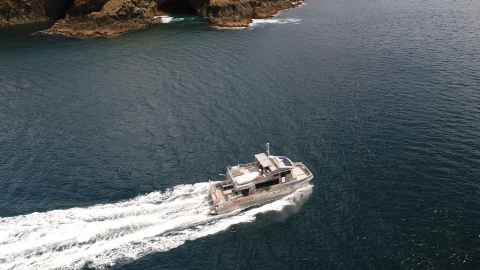University of Auckland Researchers Spearhead Efforts to Save Our Oceans
New Zealand has about 18,000 kilometres of shoreline, with more than 300 estuaries or harbours, plus an exclusive economic zone that measures 1.3 million square nautical miles. So on World Ocean Day we look at some of the work being tackled by our researchers to help restore and preserve the marine environment.
Professor of Marine Science Simon Thrush is the director of the University of Auckland’s Marine Science Centre. He says: “We’re very closely tied to our coastal oceans culturally, recreationally and economically, we see value in the natural environment, and for many people, the best chance we have to easily get into nature is to dive into the water.”
In 2023, the University launched a multi-million-dollar marine research vessel, Te Kaihōpara, as part of its commitment to marine conservation and research in Auckland’s Hauraki Gulf.
Associate Professor of Marine Science Nick Shears says the 15.9m catamaran supports many research activities including scientific diving.
“It provides us with access to the offshore islands at a time when we are seeing unprecedented changes in the Hauraki Gulf. The offshore islands are important to see what’s happening.”
Mussel and seaweed farming
A collaborative research project by the University of Auckland and the University of New England has shown environmental gains from aquaculture are possible.
The research assessed the diversity and abundance of wild fish and invertebrates on farms growing kelp and/or mussels compared to non-farmed sites in Auckland’s Hauraki Gulf and the Gulf of Maine in the US.
The research, which was supported by The Nature Conservancy in New Zealand and Maine, found mussel and seaweed farming has the potential to provide habitats for marine species, as well as providing food for people.
Professor Andrew Jeffs of the University of Auckland says the fish populations found on mussel and kelp-mussel farms in the Hauraki Gulf were equal to or greater than those at the non-farm sites, in both diversity and abundance.
Professor Jeffs says: “In an examination of gut contents of snapper living inside and outside New Zealand green-lipped mussel farms, fish living on the farm sites were also found to be eating more nutritious diets than those living in natural habitat.”
He says these results are a promising sign that mussel and kelp farms can provide both settlement and nursery habitat and an important source of food for wild fish species.
“When implemented in the right places, aquaculture could bolster biodiversity and contribute to the productivity of fisheries.”
The study is a first of its kind in New Zealand. Measuring habitat benefits in Maine and New Zealand will start to fill a critical gap in knowledge about the effects of seaweed and shellfish aquaculture on biodiversity in cold-water ecosystems.

